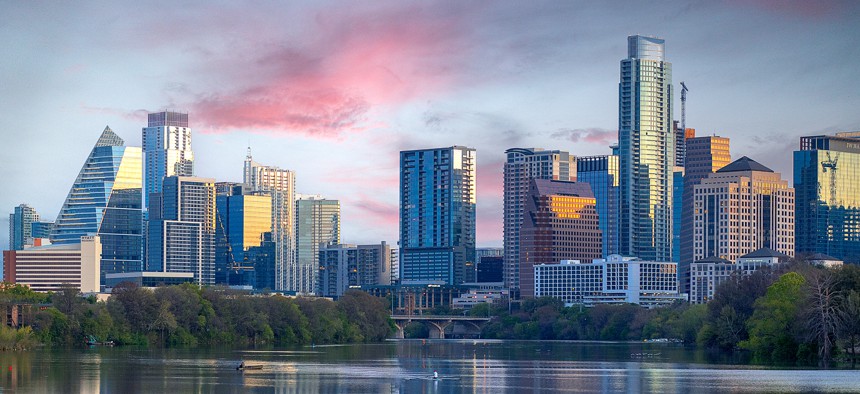What makes a top performing city?

Downtown Austin, Texas Chuck Underwood / 500px/ GettyImages
The tech and hospitality industries drive sustainable economic performance, but broadband access, affordability and resilience also play key roles, according to the Milken Institute.
The Milken Institute today released the latest edition of its Best Performing Cities Index, a report that ranks hundreds of metropolitan areas on economic performance. The Austin, Texas, area ranked No. 1 among large cities for the first time since 2013, ending the three-year reign of Provo, Utah.
Idaho Falls, Idaho, was top among small cities, performing well across nearly all metrics. In addition to a strong and diverse job market, the city also has low rates of income inequality, meaning there’s a relatively small difference between the highest and lowest earners’ incomes.
Researchers studied more than 400 metropolitan areas and compared 13 metrics across three broad categories: labor market performance, tech industry impacts and access to economic opportunities.

The report primarily uses data from 2022, representing the second full year after the onset of the pandemic. The country proved to be recovering, with the economy adding 6.3 million jobs and unemployment hitting a decade-low of 3.4% by January 2023.
But inflation remained high, and residents in cities with low wage growth did not feel the benefits of the country’s strong economic recovery. Plus, while a national view illustrates strong recovery, only about half of the cities in the study had reached or surpassed pre-pandemic employment levels by the end of 2022. More recent data is revealing a slightly more promising picture, but still more than one-quarter of cities have yet to reach pre-pandemic levels, said Maggie Switek, senior director of the Milken Institute’s research department and one of the report authors.
“There is still an ongoing recovery from the effects of the pandemic, even among the very resilient job market that we have had over the past few years,” she said.
The tech sector was rapidly recovering in 2021 but slowed the following year, as illustrated by large layoffs at companies like Meta and Amazon. In general, much of the tech sector’s growth has occurred in large cities rather than small ones.
“This slower growth, coupled with already lower high-tech concentration, implies a growing divide in high-tech presence between small and large metropolitan areas,” the report said.

While strong tech sectors often lead to population growth and quality jobs, they’re far from the primary driver of economic development in all cities.
“The cities that, to some extent, are still experiencing the fastest growth are those that have a big leisure and hospitality sectors,” Switek said. For example, Elgin, Illinois; Houston; and Richmond, Virginia, all significantly increased their standings in this year’s index compared to last, and those gains were largely driven by job growth tied to the rebounding tourism and hospitality industries.

This year’s report is the first to include metrics measuring income inequality and community resilience to natural and economic disasters.
Community resilience will be an increasingly important metric to watch as climate change worsens, said Switek. To measure resilience, researchers used census data on risk factors that affect a household’s ability to respond to a disaster, such as the ratio of adults to dependents, or whether anyone in the home has a disability that would make a quick escape difficult, she said.
Large and small cities performed about evenly when it came to resilience. In large metropolitan areas, an average of 79.7% of residents are resilient to natural disasters, compared to 78.3% of people in small cities. But that share differs across cities, the report found, and a closer look reveals that the cities that ranked lowest in the resilience category experienced more days of extreme heat in 2022 than those that ranked higher.
“This finding is alarming because it indicates that the cities least capable of responding to natural disasters are also the most likely to experience extreme heat,” the report said.
Including Idaho Falls, four of the top seven small cities were in Idaho. The report attributes this success to strong job growth coupled with a growing tech sector. These cities—Coeur d’Alene, Pocatello and Twin Falls—also had strong performances in resilience and income equality.
“It does seem like the state in general has been experiencing growth that is fast and sustainable,” Switek said, adding that Coeur d’Alene, which ranked second after Idaho Falls, saw an increase in broadband coverage, a factor that often supports job growth. In fact, many small cities saw increases in broadband coverage, even in regions that performed poorly in several other metrics. Between 2017 and 2022, the proportion of households with broadband subscriptions increased from 76% to 86% among the bottom-ranking cities.
That balance of fast and sustainable growth is difficult to achieve, especially as growth often leads to higher housing costs. Take Olympia, Washington, for example, which jumped 32 spots since last year’s report to land at No. 9 in the latest index. While the city showed the highest tech-sector GDP growth in the country, only about 66% of households are in appropriately affordable housing as the area struggles to maintain an adequate supply.






